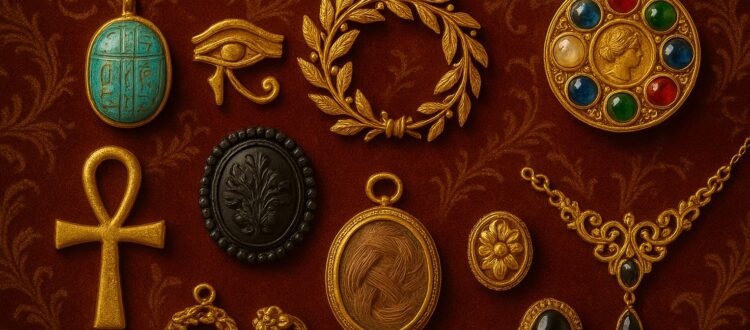The Secret Language of Jewellery: Symbolism Through Time
Throughout history, jewellery has been more than a simple adornment. Jewellery has always been a secret language of communication. Beyond its dazzling fire lie secret messages and hidden meanings. From lovers exchanging secret messages to families commemorating lost loved ones, ancient jewellery symbols carry deep meaning. Acrostic jewellery, gemstone symbolism, and even Victorian mourning jewellery all hold deep meaning and symbol.
In this post, we are going to explore the fascinating world of the hidden meanings in jewellery and how secret messages in jewellery still captivate collectors, historians, and designers even today.
Ancient Origins: Jewellery as Silent Language
In ancient times, jewellery, particularly gemstones, was considered a medium, connecting the physical and spiritual worlds. From ancient Egyptian amulets to Victorian mourning jewellery, these adornments conveyed complex messages about a wearer’s beliefs, affiliations, and life events. For example, the Egyptian Scarab Beetle symbolized the sun, rebirth, transformation, and the cyclical nature of life, while in Celtic culture, intricate knotwork designs represented interconnectedness and eternity.
The materials, colours, designs, and placement of jewellery have often meant more than words could express openly—especially in times when speaking one’s mind could be dangerous.
Secret Language Of Jewellery Through Time
Jewellery has always served as a language of protection, identity, and hidden intention. Let’s embark on a journey across cultures, decoding the secret language of jewellery.
A. Ancient Civilizations and Jewellery Symbolism
- Mesopotamia: The First Language of Jewels
Considered as one of the world’s earliest civilizations, jewellery in ancient Mesopotamia was more than an adornment; it carried a deep meaning of protection. Amulets in gold, lapis lazuli, and carnelian were believed to guard against evil spirits.
- Ancient Egypt: Language of the Divine
Ancient Egyptians wore jewellery that often encoded prayers and symbols. From Scarab beetles to Ankh motifs, every piece of jewellery was a coded message of devotion to gods and ancestors.
- Ankh motifs stood for eternal life.
- Scarab beetles symbolized rebirth and transformation.
- Lotus flowers represented creation and renewal.
- Ancient Greece: Beauty and Belief
Ancient Greek jewellery symbolized social status, divine connection, and protection. Gold indicated wealth and power, while mythological figures like Athena and symbols of nature offered divine favour and protection from evil.
- Ancient Rome: Wealth and Codes of Affection
Romans used jewellery as a marker of wealth, but it also carried private meaning. Rings often bore engraved mottos or miniature carvings of deities, signalling faith and loyalty. Roman soldiers exchanged rings as tokens of allegiance, while lovers gave jewellery to express devotion.
B. Symbolism in Arabic Royal Jewellery
Often admired for its opulence and intricate craftsmanship, the Arabic Royal jewellery had a gemstone code that allowed rulers, nobility, and artisans to embed messages within these precious adornments.
Art historians and jewellery scholars continue to discover new aspects of historical gemstone coding systems, often revealing previously unrecognised messages in museum pieces.
C. Renaissance Codes: Lover’s Language
Jewellery in the Renaissance era did function as a “lover’s language” or secret communication, using symbolic imagery, personal adornment, and even specific gemstones to convey messages of love, loyalty, and social status.
- Symbolic Imagery
Engravings and motifs on jewellery were filled with symbolic meaning. For example, animals for love and immortality, while floral motifs for life.
- Acrostic jewellery

Sometimes known as the “language of gemstones”, it spells a word using the first letter of every gemstone used.
Some of the most common acrostic words used in jewellery included:
- REGARD – Ruby, Emerald, Garnet, Amethyst, Ruby, Diamond (symbolizing admiration and love)
- DEAREST – Diamond, Emerald, Amethyst, Ruby, Emerald, Sapphire, Topaz (representing deep devotion)
- LOVE – Lapis, Opal, Vermeil, Emerald
This became a discreet lover’s code, readable only to those familiar with the gemstone alphabet.
- Secret Portraits

Miniature enamel portraits hidden inside lockets allowed lovers or allies to carry clandestine reminders. From monarchs’ secret favourites to forbidden relationships, these concealed images conveyed devotion shielded from social judgment.
- Allegorical Gem
Allegorical gems are significant gems that contain a profound hidden or moral meaning. Rubies embodied passion, sapphires stood for loyalty, and pearls for purity.
Also Read: Popular Gemstones & Their Meaning
D. European Royal Symbolism in Jewellery
When we think of royal jewellery, the first image that pops up is of jewel-studded crowns and beautiful tiaras.
- England’s Royal Jewels
The Crown Jewels of England are rich in symbolism and meaning. Key pieces include the Sovereign’s Orb and various ceremonial crowns and swords, each steeped in history and craftsmanship.
- French and European Courts
French monarchs used jewellery as symbols of absolute power. Diamonds were associated with eternity and invincibility, fitting for Louis XIV, the Sun King. In Renaissance courts, jewellery embedded with heraldic motifs conveyed loyalty, alliances, and dynastic claims.
- Victorian Mourning Jewellery
In the 19th century, jewellery became a way to publicly display grief. After the death of Prince Albert, Queen Victoria popularized mourning jewellery crafted in jet, onyx, and black enamel. Lockets with hidden compartments often carried hair, portraits, or inscriptions of the deceased. Each piece was both fashion and memorial, encoding love and loss.
E. Indian Jewellery: Symbol of Spirituality and Protection

While Western jewellery emphasised coded words and acrostics, Indian jewellery focused more on the spiritual.
- Divine Symbolism
Maharajas and queens wore ornaments as expressions of power and divine favour.
- Emeralds were thought to bring wisdom and protection.
- Rubies symbolized passion and sovereignty.
- Pearls represented purity and divine grace.
- Indian Navaratna Jewellery
Composed of nine sacred gems, each associated with a celestial body, this arrangement encoded a cosmic message of balance and protection.
- Colour Symbolism
Specific colours have deep meanings, such as gold representing purity, red symbolizing passion, and green denoting new life and harvest.
Meaning of Motifs in Jewellery
Symbols gave jewellery layers of coded meaning beyond gemstones:
- Peacock Motif
Peacocks are often seen as symbols of renewal and immortality.
- Snakes Motif
Snakes represent rebirth, eternity, and protection.
- Elephant Motif
Elephants represent strength, power, and wisdom.
- Flower Motif
Floral designs are a universal symbol of beauty, nature, and the cycle of life, with each flower having its own symbol.
- Stars and crescent moons
Stars, moon and other celestial motifs represent guidance, destiny, and divine protection.
Contemporary Jewellery: New Codes and Digital Secrets
Today, jewellery continues to serve as a vessel of hidden messages, but in new and evolving forms.
- Personalization: Modern pieces often include initials, fingerprints, or even soundwave engravings of voices—intimate codes between giver and receiver.
- Technology-Infused Jewellery: Smart rings and lockets, with encrypted digital memories or photos, revisit the ancestral role of jewellery as a hidden vessel but update it with twenty-first-century materials.
Jewellery as an Eternal Whisper
From the sacred scarabs of Egypt to AI-enhanced rings today, jewellery has always served as more than adornment. Even today, when we wear a ring, pendant, or bracelet, we carry hidden meanings with us. Jewellery remains what it has always been—a silent message worn close to the heart.






